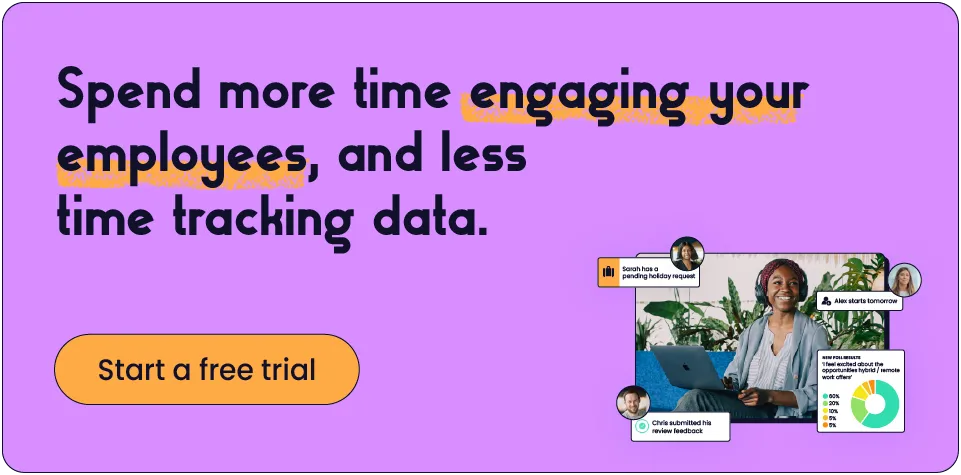What employee engagement metrics should you measure at your small business?

Most small business owners know that employee engagement matters, but probably aren’t entirely sure why, or how they should measure it.
I’ve worked at Charlie since the beginning, and oversee all of our employee engagement. So I understand how it can all sound a bit abstract, and how difficult it can be to quantify.
If you want to know what employee engagement metrics you should be measuring, then this is the guide for you.
By the end of it, you’ll understand exactly what employee engagement metrics are, and how you can use them to measure employee engagement at your own business.
Let’s get started…
What are employee engagement metrics?
Employee engagement metrics are used to capture the mood and level of engagement of a team.
In a small business setting, it’s easy to assume that you know how all your employees are feeling — you’re a small company, you work closely together, surely you’d know if someone was unhappy or unfulfilled…
But the fact you’re so close-knitinterest might actually mean the opposite is true, and your employees might feel like they can’t say how they’re really feeling. Which is why measuring employee engagement regularly and consistently at a small business is so important.
Employee engagement metrics allow you to see how your team is feeling ‘in the moment’. If you measure employee engagement regularly, over time you’ll build up a picture and be able to spot trends, patterns, or sudden drops in your employees’ engagement.
Why is employee engagement so important in the modern workplace?
Though it’s difficult to quantify, employee engagement is important because of the significant business benefits it brings about.
An engaged team is a more loyal and productive team, so it’s very much in a business’ interest to nurture employee engagement and track how effective those efforts are.
If you’re doing something that’s actively and consistently engaging your employees, it’s likely to be one of the reasons for your business success (and were you to stop doing it then that same success would be impacted). And if something’s not working, then it could be actively working against you and disengaging your team.
If you build employee engagement into your business strategy then you’ll likely see many or all of the following:
- Happier, healthier, and more positive employees
- Increases in productivity levels
- Improved communication across teams and departments
- Lower rates of absenteeism
- Better retention rates
- Managerial development (i.e. better leaders)
- Business growth
Employee engagement metrics help you to better understand your employees, and what they need to stay motivated and engaged in their roles and at your company.
You can use the insight from your engagement metrics to boost and nurture a positive workplace culture and ensure and support a happy and productive team.
What are the challenges of measuring employee engagement?
As I’ve already mentioned, employee engagement can be difficult to quantify and that’s definitely one of its biggest challenges. A lot about it sounds pretty abstract, and many business owners and their HR teams struggle to know which employee engagement metrics they should be focusing on.
Typically in business, data is numerical and therefore easier to quantify. But employee engagement could be an emotion, a sense of connection or belonging, or a feeling of loyalty and contentment — all of which are much more difficult to measure. And because of this, in many companies, this qualitative and hugely useful data goes largely ignored.
Another challenge, especially in a small business setting, is a lack of technology. Technology exists to help you collect, measure and track employee engagement metrics, but in many cases, it’s too expensive or complex for small businesses to take advantage of.
This means that attempts to measure engagement don’t quite hit the mark: surveys are generic and infrequent, and responses to employee feedback are delayed or simply don’t happen at all.
If you combine all of these challenges together, they present quite an obstacle. And if you’re a small business, you’ll likely come up against even more…
Common barriers for small businesses:
Limited resources - with typically fewer resources (including time, people and budget), implementing and maintaining an employee engagement tracking system is a challenge for a small business.
Time constraints - small business owners often wear multiple hats, and allocating time to consistently track and analyse engagement metrics can be difficult amidst other responsibilities.
Defining relevant metrics - identifying which metrics are the most relevant and meaningful for better understanding employee engagement isn’t simple. Struggling to determine which metrics align with specific goals is not uncommon for small business owners.
Lack of specialised HR tech - as I mentioned above, there are all sorts of advanced HR technology tools specifically designed for tracking employee engagement, but small businesses are unlikely to have access to them. On top of that, setting up one of these comprehensive systems is often resource-intensive and complex.
Interpreting data - once the metrics have been collected, there’s the issue of interpreting the data. Without any previous experience or expertise, another barrier is knowing how to effectively analyse employee engagement.
Sound familiar?
Well, don’t worry too much — because none of these barriers are insurmountable. At Charlie, we help startups and small businesses successfully overcome these obstacles every day.
And we can help you too.
What employee engagement metrics should you track?
Measuring your employees’ commitment and connection to their jobs and to your business requires several different engagement metrics. This is because employee engagement isn’t a fixed thing: people’s feelings and perceptions will shift and change during their time at your company.
To capture this, and to build up a solid picture of employee engagement at your small business, you need to measure different metrics regularly and consistently.
The best way to do that is to approach employee engagement strategically — employee engagement needs to be part of everything you do. And tracking certain metrics, as well as setting HR KPIs, will focus these efforts.
Employee engagement metrics examples for small businesses:
- Employee engagement surveys - engagement surveys give your team a voice and help you to better understand them. You need to run these annually at the very least.
- Pulse surveys - short, specific surveys that you regularly send to your team. They allow you to take the ‘pulse’ of the company at any one time.
- Employee Net Promoter Score - tells you on a scale of 0-10 whether your current employees would refer you as an employer to their family and friends.
- Average tenure - if this is low or decreasing, it’s likely that engagement and employee satisfaction are also going down.
- Retention rate - similar to average tenure, if it’s low or going down then engagement probably is too.
- Turnover rate - spot trends, patterns and anomalies in your turnover. Are people moving on quickly? If so, why?
- Absenteeism rate - engaged employees tend to be around more. High rates of absenteeism may suggest that people are feeling the opposite.
- Attrition rate – not to be confounded with turnover rate, employee attrition is when an employee leaves the company and is not replaced by the business, leaving a gap in your headcount.
How to track employee engagement metrics
Now you know what employee engagement metrics to track, you’ve just got to figure out how to track them…
I’d like to take a moment to properly introduce you to Charlie, and explain how you can use our HR dashboards, reports and engagement surveys for your qualitative data.
Charlie’s built-in engagement reports allow you to easily track employee engagement metrics. These built-in reports include:
- Average tenure
- Retention rate
- Turnover rate
And you can say goodbye to formulas and messy spreadsheets because Charlie calculates everything for you.
In addition to these ready-to-go reports, you can also run your engagement surveys in Charlie:
1. Choose from a library of survey templates built by qualified HR experts. If none of them are suitable, you can build your own survey from scratch.
2. Once you’ve chosen your template, it takes just one click to send the survey to your team.
3. Our system anonymises all data, so your team will feel safe to give their honest feedback about your business.
If you’re worried about declining engagement, these surveys will help you to get to the root cause.
With Charlie, you can launch engagement surveys, track responses and analyse results, all in one place. We’re a small business, just like you. So we understand exactly what you need. Try Charlie for free.




